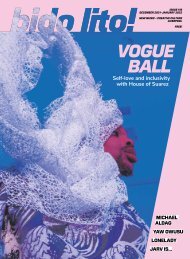Issue 113 / April-May 2021
April-May 2021 issue of Bido Lito! magazine. Featuring: PIXEY, AYSTAR, SARA WOLFF, DIALECT, AMBER JAY, JANE WEAVER, TATE COLLECTIVE, DEAD PIGEON GALLERY, DAVID ZINK YI, SAM BATLEY, FURRY HUG, FELIX MUFTI-WRIGHT, STEALING SHEEP and much more.
April-May 2021 issue of Bido Lito! magazine. Featuring: PIXEY, AYSTAR, SARA WOLFF, DIALECT, AMBER JAY, JANE WEAVER, TATE COLLECTIVE, DEAD PIGEON GALLERY, DAVID ZINK YI, SAM BATLEY, FURRY HUG, FELIX MUFTI-WRIGHT, STEALING SHEEP and much more.
Create successful ePaper yourself
Turn your PDF publications into a flip-book with our unique Google optimized e-Paper software.
34<br />
RECOVERY<br />
When Damien John Kelly House, an<br />
abstinence-led residential recovery centre,<br />
was established in Wavertree in 2019, it was<br />
met with scorn and disapproval from local<br />
residents. Two years on, the house is a core<br />
part of the Wavertree community, offering those<br />
in recovery a chance to reconnect with society<br />
through a programme of arts, creativity and sport.<br />
Paul Fitzgerald speaks to its residents and those<br />
behind the house about its continuing journey.<br />
all fuming here. There’s a school over the road from it, there’s a nursery<br />
round the back of it. You’re going to have druggies robbing and making<br />
more crime for the area.”<br />
“We’re<br />
“We feel like every garbage comes to Wavertree.”<br />
“It’s the last straw that broke the camel’s back.”<br />
In a 2019 article curiously headlined ‘An abandoned pub, a drug rehab row and the long decline<br />
of one of our most famous streets’, the Liverpool Echo spoke to business owners in the Wavertree<br />
area following ferocious local outcry at the suggestion that a residential centre for recovering addicts<br />
could be granted planning permission at the old police station on Wavertree High Street. At one<br />
particularly ill-tempered planning meeting, objectors railed against representatives of what is now<br />
Damien John Kelly House, with shouts of “shame” and “disgrace”. One dissenter going as far as telling<br />
them to “Burn in hell”.<br />
When the Liverpool Watch Committee declared Wavertree to be a safe place for policemen to live<br />
in the late 1800s, the decision was made to close the old lock-up on the village green and build a new<br />
station on the high street. A warm office for the officers and a good amount of hard brick cells for the<br />
regulars. Short-term stays for long-term guests. And on just a two-mile stretch containing more than 30<br />
pubs, regular guests were in plentiful supply. Those who lived in the neat terraced streets of Wavertree<br />
were a community of thousands, the great majority of them railworkers. The work was hard and the living<br />
wasn’t easy, but people supported each other in whatever way they could. Such was, and is, working-class<br />
life in Liverpool.<br />
It’s understandable to see why the Wavertree residents of today were originally in such objection to the<br />
idea of recovering addicts moving into the area. They were right. Their area has declined. Pubs and shops have<br />
closed, there’s very little footfall compared to even recent times, and local businesses were already struggling<br />
long before Coronavirus came to stay. The community felt fractured, lost to the wealth of investment in the city<br />
centre; like so many across the city, they felt abandoned.<br />
On top of this, and as with so many of us, they didn’t understand what happens to addicts in recovery, or<br />
even what the word means in the context of addiction. Through fear, ignorance and the stigma still attached to<br />
addiction (or more likely through a heady combination of all three), they perceived the opening of Damien John<br />
Kelly House to be a further threat to their weakening sense of community. What they didn’t perceive, certainly at<br />
that time, was that it could become a valuable asset, something to help grow the community from within and create<br />
new opportunities for all.<br />
Damien John Kelly House is an abstinence-led residential recovery centre. The residents are there because they<br />
want to be. Some, but not all, have completed a 12-week rehabilitation, but it’s not a condition of acceptance. They’re<br />
not in active addiction, but are seeking the next stage: recovery. If their recovery is robust and reliable, if they’re<br />
familiar with mutual aid groups and the personal work they need to do, they can be welcomed into the programme.<br />
Like the concept of community, recovery is not an end-game or destination, more an ongoing process, fluctuating<br />
and growing at each turn. Recovery is reconnection; with yourself, with family, community and society. It is based on<br />
honesty, on acceptance and willing. Especially willing. Recovery can only begin with willing, just as addiction begins<br />
with trauma. There being no such thing as a ‘gateway drug’; trauma, all too often, is the true gateway to addiction.<br />
Recovery never really ends.<br />
To look at the old police station today, you wouldn’t know its current use. There are no signs, no banners. No visible<br />
celebration of their purpose. But then, we don’t generally put signs on our homes to proclaim who we are and what we<br />
do. And Damien John Kelly House is, first and foremost, a home. People live their lives there in ways they could have never<br />
imagined when in the deepest recesses of addiction and life had left them broken. They thrive and flourish there. (When<br />
I left after one of my visits for this article, I noticed the motto in Latin on the frontage of Wavertree Town Hall: ‘Sub Umba<br />
Floresco’ which translates as ‘I Flourish in The Shade’).<br />
Damien John Kelly, who the house is named after, was a catalyst. He brought people together. As an integral part in<br />
The Brink – Britain’s first dry bar – Damien instilled a sense of hope in people who, like he had done, were turning their lives<br />
around. He was a powerful force for change in people, an example and an inspiration.<br />
PJ Smith, Recovery Lead at the house, was just one of the many people who turned his life around with the support,<br />
guidance, love and encouragement of Damien.<br />
Writing of his friend and mentor in a previous issue of Bido Lito!, he noted how he gave people “the impetus to change their<br />
own lives. Instilling hope in people… He didn’t change his life by magic. He faced himself head-on. Sheer courage and willingness.<br />
He always used to say, ‘If I can do it, anyone can’. He’s right, y’know? Hope rather than despair.”<br />
This community is just a fraction of the huge legacy Damien Kelly left when he died suddenly and tragically in his sleep in<br />
2019. In many ways, he lives on in the lives of those he never met.<br />
The first part of becoming part of a community is to know that community and, with that in mind, the two disparate groups<br />
came together as one at an open-door event when Damien John Kelly House opened. Residents and staff were on-hand to welcome<br />
them, answer any questions, dispel a myth or two and, at the event’s conclusion, even to accept apologies from some of the most<br />
previously vehement objectors. Honesty, acceptance and willing.<br />
“We had over 300 objections when we started this,” Head of Services Jacquie Johnston-Lynch told me. “And now we’re in<br />
demand,” adds PJ.<br />
In more ways than one. The charity Action on Addiction reports an 86 per cent spike in those seeking help compared with this time<br />
last year. As demand for addiction services grows, opportunities for post-rehab recovery support remain depressingly, worryingly and

















